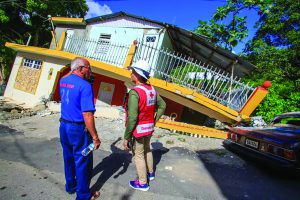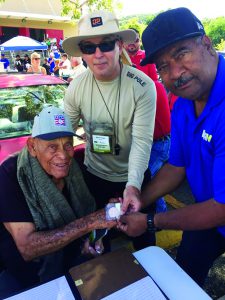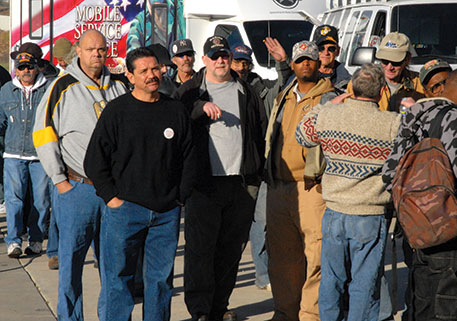
DAV Department of Puerto Rico springs into action to assist veterans after powerful earthquakes rock the island
Carlos Perez-Cabrera was at a concert with his 5-year-old grandson when the ground beneath Ponce, Puerto Rico, began to lightly rumble. But that earthquake—gentle enough not to cause any injuries or damage—pales in comparison to the mighty 6.4-magnitude tremor that struck the following morning.
The Jan. 7 temblor, which caused parts of city hall to come tumbling down, was the latest quake in a string of intense tectonic shifts felt throughout the island. It left hundreds of homes in ruins and displaced thousands. In addition to Ponce, four other towns—Guánica, Guayanilla, Peñuelas and Yauco—endured some of the worst destruction.
“Most of the southwest area of the island was damaged,” said Perez-Cabrera, commander of the Department of Puerto Rico. “In Ponce, more than 150 houses were destroyed.”
Gov. Wanda Vázquez Garced issued a state of emergency and activated the National Guard to assist in recovery efforts as most Puerto Rico homes lost power.
While the tragic events wreaked havoc on countless citizens, DAV members and officials across the island mobilized to help hundreds of affected veterans mere hours after the quake.
Angel Quiñones, treasurer of Chapter 4 in Ponce, was sitting at home with his wife in Yauco when the “big one” hit. Dozens of houses were damaged, including his, but that didn’t stop him from quickly organizing to bring 90 other residents to a nearby abandoned school, which became one of five makeshift camps for earthquake victims seeking refuge.
In addition to shepherding his neighbors to safety, Quiñones began coordinating efforts with other DAV chapters across the island to distribute canned food, personal hygiene items and other supplies.
“DAV chapters were always calling, asking if anybody needed anything and making sure we were safe,” he said. “It was incredible work.”

To help assess and track veterans in need, Perez-Cabrera and Department Adjutant Delvis Collazo-Rivera traveled around the southwestern area visiting the various temporary camps. Unable to take the main roads, the duo split up to cover more ground. However, a few days after the Ponce earthquake, another hit.
“Carlos said he had to call me back because the ground was shaking,” Collazo-Rivera said of Perez-Cabrera, who luckily was not harmed. “When he did, he told me his car jumped from one lane to another.”
Collazo-Rivera continued to survey the camps, identifying veterans who needed assistance.
“We made a list of veterans who were there because we wanted to help them with DAV funds,” added Collazo-Rivera.
Those funds included more than 150 disaster relief vouchers for veterans and their families who lost their homes, said DAV Service Officer Alex Martinez.
“The way national headquarters, the Department of Puerto Rico and the chapters came together to assist needy veterans and their families in the southeast area is an example of DAV’s human spirit,” said Martinez. “Individuals at the camps were uplifted despite the traumatizing events that occurred.”
But help didn’t stop there.
Perez-Cabrera, Collazo-Rivera and others shared data with Department of Veterans Affairs officials in Puerto Rico, who deployed a VA team to evaluate and provide lifesaving services to veterans in the areas affected by the earthquakes. As hundreds received care, Carlos Escobar, director of the VA Caribbean Healthcare System in San Juan, wrote to Collazo-Rivera, thanking him for DAV’s rapid response in assisting ill and injured veterans.
“More than 370 persons were impacted by the missions,” the letter says. “Services provided included health screenings, mental health counseling, and medication refills, among others.”
While hundreds of lives were helped and changed in the course of DAV springing into action, earthquakes continue to persist across the island and some areas are still recovering.
The city center in Guánica is completely shut down, said Perez-Cabrera. And the historic Iglesia Inmaculada Concepción—the Catholic church built in 1841 in Guayanilla—remains in ruins.
Perez said he wouldn’t forget the destruction anytime soon.
“It’s heartbreaking to see a nice two-story house crumble to the ground,” he said. “It hurts you because you see somebody spent their retirement money to make a nice house, and then in 10 seconds, it’s not there anymore.
“It’s certainly not easy.”




